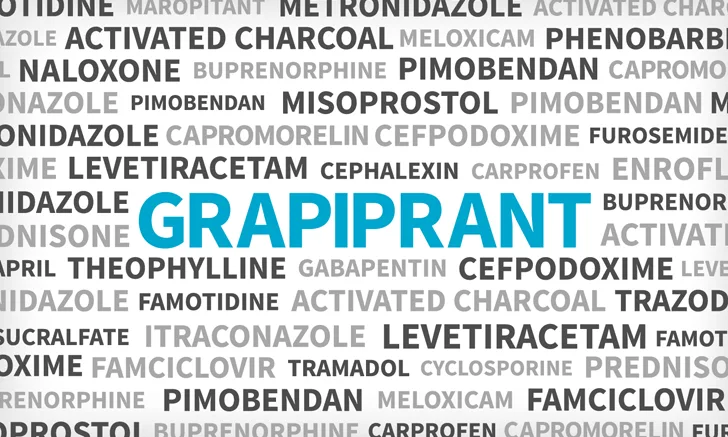Grapiprant

Non-Steroidal Anti-Inflammatory Medication (Systemic Drug)
Prescriber Highlights
Prostaglandin E2 EP4-receptor antagonist (systemic drug), a new class of NSAID for treating osteoarthritis pain in dogs that does not inhibit cyclooxygenase (COX)
Potentially causes fewer severe adverse effects in dogs than other NSAIDs
GI effects (eg, vomiting, diarrhea) possible
Uses, Indications
Approved for control of pain and inflammation associated with osteoarthritis in dogs
Contraindications, Warnings
Contraindications
Patients with hypersensitivity to grapiprant or its components
Warnings
Grapiprant has not been evaluated in dogs younger than 9 months of age or weighing less than 8 lbs (3.6 kgs)
Safe use has not been established in dogs used for breeding or in pregnant or lactating dogs
Side Effects
GI distress (eg, vomiting; diarrhea; decreased appetite; mucoid, watery, or bloody stools)
Decreased serum albumin and total protein
Drug Interactions
Grapiprant is a substrate of P-glycoprotein transport, but no clinically relevant drug interactions have been identified
No inhibition of metabolic pathways mediated by cytochrome P450 isoenzymes CYP1A2, CYP2C9, CYP2C19, CYP2D6, or CYP3A4
Concurrent use with other anti-inflammatory drugs (eg, COX-inhibiting NSAIDs, corticosteroids) should be avoided
Washout period suggested when switching from corticosteroids or COX-inhibiting NSAIDs to grapiprant
Monitoring
Clinical efficacy, adverse events
Appetite
Emesis
Stool characteristics
Client Information
May be given with or without food; however, if vomiting occurs, give with food
Most common adverse effects include vomiting, diarrhea, and decreased appetite
Dosage Forms
Grapiprant flavored tablets: 20 mg, 60 mg, and 100 mg
‒Compiled and summarized from Plumb’s® Veterinary Drugs by Shannon Palermo, VMD
Information about this drug was adapted from Plumb’s® Veterinary Drugs. Further details and more therapeutics can be found with a subscription at plumbsveterinarydrugs.com